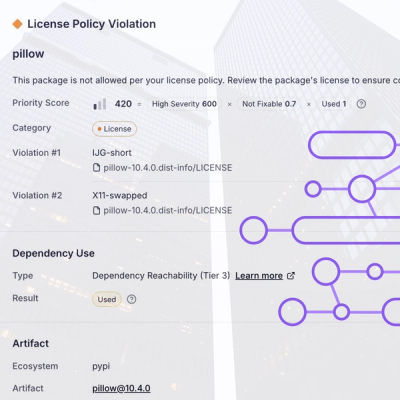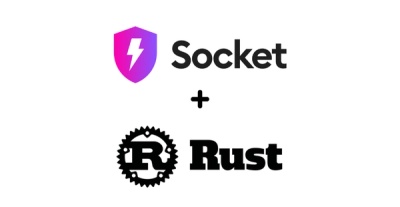
Research
/Security News
Critical Vulnerability in NestJS Devtools: Localhost RCE via Sandbox Escape
A flawed sandbox in @nestjs/devtools-integration lets attackers run code on your machine via CSRF, leading to full Remote Code Execution (RCE).
github.com/disintegration/imaging
Package imaging provides basic image processing functions (resize, rotate, crop, brightness/contrast adjustments, etc.).
All the image processing functions provided by the package accept any image type that implements image.Image interface
as an input, and return a new image of *image.NRGBA type (32bit RGBA colors, non-premultiplied alpha).
go get -u github.com/disintegration/imaging
http://godoc.org/github.com/disintegration/imaging
A few usage examples can be found below. See the documentation for the full list of supported functions.
// Resize srcImage to size = 128x128px using the Lanczos filter.
dstImage128 := imaging.Resize(srcImage, 128, 128, imaging.Lanczos)
// Resize srcImage to width = 800px preserving the aspect ratio.
dstImage800 := imaging.Resize(srcImage, 800, 0, imaging.Lanczos)
// Scale down srcImage to fit the 800x600px bounding box.
dstImageFit := imaging.Fit(srcImage, 800, 600, imaging.Lanczos)
// Resize and crop the srcImage to fill the 100x100px area.
dstImageFill := imaging.Fill(srcImage, 100, 100, imaging.Center, imaging.Lanczos)
Imaging supports image resizing using various resampling filters. The most notable ones:
Lanczos - A high-quality resampling filter for photographic images yielding sharp results.CatmullRom - A sharp cubic filter that is faster than Lanczos filter while providing similar results.MitchellNetravali - A cubic filter that produces smoother results with less ringing artifacts than CatmullRom.Linear - Bilinear resampling filter, produces smooth output. Faster than cubic filters.Box - Simple and fast averaging filter appropriate for downscaling. When upscaling it's similar to NearestNeighbor.NearestNeighbor - Fastest resampling filter, no antialiasing.The full list of supported filters: NearestNeighbor, Box, Linear, Hermite, MitchellNetravali, CatmullRom, BSpline, Gaussian, Lanczos, Hann, Hamming, Blackman, Bartlett, Welch, Cosine. Custom filters can be created using ResampleFilter struct.
Resampling filters comparison
Original image:

The same image resized from 600x400px to 150x100px using different resampling filters. From faster (lower quality) to slower (higher quality):
| Filter | Resize result |
|---|---|
imaging.NearestNeighbor |  |
imaging.Linear |  |
imaging.CatmullRom |  |
imaging.Lanczos |  |
dstImage := imaging.Blur(srcImage, 0.5)
Sigma parameter allows to control the strength of the blurring effect.
| Original image | Sigma = 0.5 | Sigma = 1.5 |
|---|---|---|
 |  |  |
dstImage := imaging.Sharpen(srcImage, 0.5)
Sharpen uses gaussian function internally. Sigma parameter allows to control the strength of the sharpening effect.
| Original image | Sigma = 0.5 | Sigma = 1.5 |
|---|---|---|
 |  |  |
dstImage := imaging.AdjustGamma(srcImage, 0.75)
| Original image | Gamma = 0.75 | Gamma = 1.25 |
|---|---|---|
 |  |  |
dstImage := imaging.AdjustContrast(srcImage, 20)
| Original image | Contrast = 15 | Contrast = -15 |
|---|---|---|
 |  |  |
dstImage := imaging.AdjustBrightness(srcImage, 20)
| Original image | Brightness = 10 | Brightness = -10 |
|---|---|---|
 |  |  |
dstImage := imaging.AdjustSaturation(srcImage, 20)
| Original image | Saturation = 30 | Saturation = -30 |
|---|---|---|
 |  |  |
Most probably, the given image contains the EXIF orientation tag.
The stadard image/* packages do not support loading and saving
this kind of information. To fix the issue, try opening images with
the AutoOrientation decode option. If this option is set to true,
the image orientation is changed after decoding, according to the
orientation tag (if present). Here's the example:
img, err := imaging.Open("test.jpg", imaging.AutoOrientation(true))
imaging and gift packages?imaging
is designed to be a lightweight and simple image manipulation package.
It provides basic image processing functions and a few helper functions
such as Open and Save. It consistently returns *image.NRGBA image
type (8 bits per channel, RGBA).
gift supports more advanced image processing, for example, sRGB/Linear color space conversions. It also supports different output image types (e.g. 16 bits per channel) and provides easy-to-use API for chaining multiple processing steps together.
package main
import (
"image"
"image/color"
"log"
"github.com/disintegration/imaging"
)
func main() {
// Open a test image.
src, err := imaging.Open("testdata/flowers.png")
if err != nil {
log.Fatalf("failed to open image: %v", err)
}
// Crop the original image to 300x300px size using the center anchor.
src = imaging.CropAnchor(src, 300, 300, imaging.Center)
// Resize the cropped image to width = 200px preserving the aspect ratio.
src = imaging.Resize(src, 200, 0, imaging.Lanczos)
// Create a blurred version of the image.
img1 := imaging.Blur(src, 5)
// Create a grayscale version of the image with higher contrast and sharpness.
img2 := imaging.Grayscale(src)
img2 = imaging.AdjustContrast(img2, 20)
img2 = imaging.Sharpen(img2, 2)
// Create an inverted version of the image.
img3 := imaging.Invert(src)
// Create an embossed version of the image using a convolution filter.
img4 := imaging.Convolve3x3(
src,
[9]float64{
-1, -1, 0,
-1, 1, 1,
0, 1, 1,
},
nil,
)
// Create a new image and paste the four produced images into it.
dst := imaging.New(400, 400, color.NRGBA{0, 0, 0, 0})
dst = imaging.Paste(dst, img1, image.Pt(0, 0))
dst = imaging.Paste(dst, img2, image.Pt(0, 200))
dst = imaging.Paste(dst, img3, image.Pt(200, 0))
dst = imaging.Paste(dst, img4, image.Pt(200, 200))
// Save the resulting image as JPEG.
err = imaging.Save(dst, "testdata/out_example.jpg")
if err != nil {
log.Fatalf("failed to save image: %v", err)
}
}
Output:

FAQs
Unknown package
Did you know?

Socket for GitHub automatically highlights issues in each pull request and monitors the health of all your open source dependencies. Discover the contents of your packages and block harmful activity before you install or update your dependencies.

Research
/Security News
A flawed sandbox in @nestjs/devtools-integration lets attackers run code on your machine via CSRF, leading to full Remote Code Execution (RCE).

Product
Customize license detection with Socket’s new license overlays: gain control, reduce noise, and handle edge cases with precision.

Product
Socket now supports Rust and Cargo, offering package search for all users and experimental SBOM generation for enterprise projects.